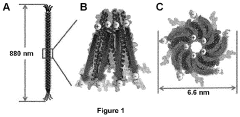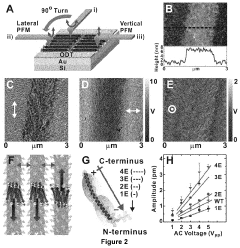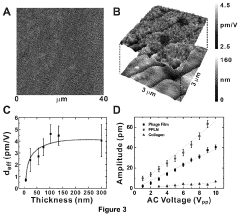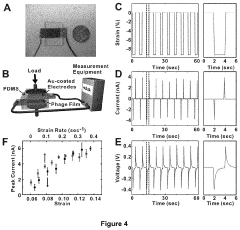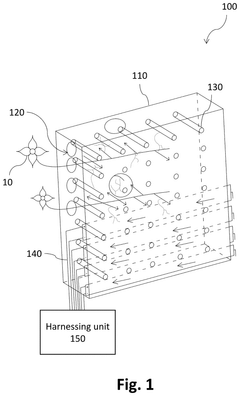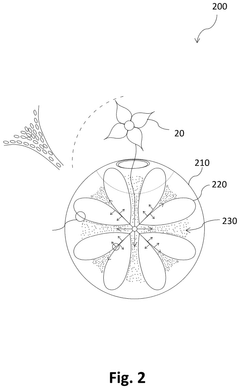Clean Energy Solutions Driven by Piezoelectric Advances
JUL 17, 20259 MIN READ
Generate Your Research Report Instantly with AI Agent
Patsnap Eureka helps you evaluate technical feasibility & market potential.
Piezoelectric Energy Harvesting: Background and Objectives
Piezoelectric energy harvesting has emerged as a promising technology in the quest for clean and sustainable energy solutions. This innovative approach harnesses the piezoelectric effect, which allows certain materials to generate an electric charge in response to applied mechanical stress. The concept of piezoelectricity dates back to the late 19th century when Pierre and Jacques Curie first discovered this phenomenon in various crystals.
Over the past few decades, advancements in materials science and nanotechnology have significantly enhanced the efficiency and applicability of piezoelectric energy harvesting. The primary objective of this technology is to convert ambient mechanical energy, such as vibrations, pressure, or strain, into usable electrical energy. This conversion process offers a unique opportunity to power small electronic devices, sensors, and even contribute to larger-scale energy generation systems.
The development of piezoelectric energy harvesting aligns with the global push towards renewable energy sources and the reduction of carbon emissions. As the world grapples with the challenges of climate change and energy security, piezoelectric technology presents a viable alternative to traditional power generation methods, particularly in scenarios where conventional energy sources are impractical or unavailable.
One of the key goals in piezoelectric energy harvesting research is to improve the energy conversion efficiency of piezoelectric materials. This involves exploring new material compositions, optimizing crystal structures, and developing novel device architectures. Researchers are also focusing on expanding the range of applications for this technology, from powering wearable devices and implantable medical sensors to harvesting energy from road vibrations and ocean waves.
Another critical objective is to address the scalability of piezoelectric energy harvesting systems. While the technology has shown promise in small-scale applications, there is ongoing research to determine its feasibility for larger-scale energy production. This includes investigating ways to integrate piezoelectric harvesters into existing infrastructure and developing new designs that can capture and convert mechanical energy more effectively on a broader scale.
As we look towards the future, the evolution of piezoelectric energy harvesting is closely tied to advancements in related fields such as flexible electronics, smart materials, and the Internet of Things (IoT). The convergence of these technologies is expected to open up new possibilities for self-powered devices and autonomous systems, potentially revolutionizing sectors like healthcare, transportation, and environmental monitoring.
Over the past few decades, advancements in materials science and nanotechnology have significantly enhanced the efficiency and applicability of piezoelectric energy harvesting. The primary objective of this technology is to convert ambient mechanical energy, such as vibrations, pressure, or strain, into usable electrical energy. This conversion process offers a unique opportunity to power small electronic devices, sensors, and even contribute to larger-scale energy generation systems.
The development of piezoelectric energy harvesting aligns with the global push towards renewable energy sources and the reduction of carbon emissions. As the world grapples with the challenges of climate change and energy security, piezoelectric technology presents a viable alternative to traditional power generation methods, particularly in scenarios where conventional energy sources are impractical or unavailable.
One of the key goals in piezoelectric energy harvesting research is to improve the energy conversion efficiency of piezoelectric materials. This involves exploring new material compositions, optimizing crystal structures, and developing novel device architectures. Researchers are also focusing on expanding the range of applications for this technology, from powering wearable devices and implantable medical sensors to harvesting energy from road vibrations and ocean waves.
Another critical objective is to address the scalability of piezoelectric energy harvesting systems. While the technology has shown promise in small-scale applications, there is ongoing research to determine its feasibility for larger-scale energy production. This includes investigating ways to integrate piezoelectric harvesters into existing infrastructure and developing new designs that can capture and convert mechanical energy more effectively on a broader scale.
As we look towards the future, the evolution of piezoelectric energy harvesting is closely tied to advancements in related fields such as flexible electronics, smart materials, and the Internet of Things (IoT). The convergence of these technologies is expected to open up new possibilities for self-powered devices and autonomous systems, potentially revolutionizing sectors like healthcare, transportation, and environmental monitoring.
Market Analysis for Clean Energy Solutions
The market for clean energy solutions driven by piezoelectric advances is experiencing significant growth and transformation. As global concerns about climate change and environmental sustainability intensify, there is an increasing demand for innovative, renewable energy technologies. Piezoelectric materials, which generate electricity in response to mechanical stress, are emerging as a promising avenue for clean energy generation.
The potential applications of piezoelectric technology in the clean energy sector are diverse and expanding. From harvesting energy from footsteps in high-traffic areas to capturing vibrations from industrial machinery, piezoelectric solutions offer unique opportunities for energy generation in previously untapped scenarios. This versatility is driving market interest across various industries, including transportation, infrastructure, and consumer electronics.
One of the key factors propelling market growth is the increasing focus on energy efficiency and sustainability in urban development. Smart cities and green building initiatives are incorporating piezoelectric technologies to harness energy from everyday activities, such as vehicle movement on roads or the flow of water in pipes. This integration of energy harvesting into existing infrastructure presents a significant market opportunity for piezoelectric solutions.
The automotive sector is another area showing strong potential for piezoelectric clean energy applications. With the rise of electric and hybrid vehicles, there is growing interest in technologies that can recover energy from vehicle vibrations, tire pressure, and suspension systems. This not only improves overall energy efficiency but also aligns with the industry's push towards more sustainable transportation solutions.
In the consumer electronics market, piezoelectric technology is gaining traction for its potential in self-powered devices and wearable technology. The ability to generate power from body movements or ambient vibrations opens up new possibilities for long-lasting, maintenance-free electronic products, addressing the ever-present challenge of battery life and disposal.
Despite the promising outlook, the market for piezoelectric clean energy solutions faces some challenges. The technology is still evolving, and there are ongoing efforts to improve the efficiency and scalability of piezoelectric energy harvesting systems. Additionally, the initial cost of implementation can be high, which may slow adoption rates in some sectors.
Looking ahead, the market is expected to benefit from ongoing research and development efforts aimed at enhancing the performance and cost-effectiveness of piezoelectric materials. As the technology matures and production scales up, it is likely to become more economically viable for a wider range of applications, further driving market growth in the clean energy sector.
The potential applications of piezoelectric technology in the clean energy sector are diverse and expanding. From harvesting energy from footsteps in high-traffic areas to capturing vibrations from industrial machinery, piezoelectric solutions offer unique opportunities for energy generation in previously untapped scenarios. This versatility is driving market interest across various industries, including transportation, infrastructure, and consumer electronics.
One of the key factors propelling market growth is the increasing focus on energy efficiency and sustainability in urban development. Smart cities and green building initiatives are incorporating piezoelectric technologies to harness energy from everyday activities, such as vehicle movement on roads or the flow of water in pipes. This integration of energy harvesting into existing infrastructure presents a significant market opportunity for piezoelectric solutions.
The automotive sector is another area showing strong potential for piezoelectric clean energy applications. With the rise of electric and hybrid vehicles, there is growing interest in technologies that can recover energy from vehicle vibrations, tire pressure, and suspension systems. This not only improves overall energy efficiency but also aligns with the industry's push towards more sustainable transportation solutions.
In the consumer electronics market, piezoelectric technology is gaining traction for its potential in self-powered devices and wearable technology. The ability to generate power from body movements or ambient vibrations opens up new possibilities for long-lasting, maintenance-free electronic products, addressing the ever-present challenge of battery life and disposal.
Despite the promising outlook, the market for piezoelectric clean energy solutions faces some challenges. The technology is still evolving, and there are ongoing efforts to improve the efficiency and scalability of piezoelectric energy harvesting systems. Additionally, the initial cost of implementation can be high, which may slow adoption rates in some sectors.
Looking ahead, the market is expected to benefit from ongoing research and development efforts aimed at enhancing the performance and cost-effectiveness of piezoelectric materials. As the technology matures and production scales up, it is likely to become more economically viable for a wider range of applications, further driving market growth in the clean energy sector.
Current Challenges in Piezoelectric Technology
Despite significant advancements in piezoelectric technology, several challenges persist in its widespread adoption for clean energy solutions. One of the primary obstacles is the limited energy conversion efficiency of piezoelectric materials. Current materials typically exhibit conversion rates below 50%, which restricts their practical application in large-scale energy harvesting systems. Improving this efficiency remains a key focus for researchers and engineers in the field.
Another significant challenge lies in the durability and longevity of piezoelectric devices. When subjected to continuous mechanical stress, these materials can degrade over time, leading to reduced performance and potential failure. This issue is particularly critical in applications such as roadway energy harvesting or structural health monitoring, where devices are expected to operate reliably for extended periods under harsh conditions.
The scalability of piezoelectric technology also presents a considerable hurdle. While small-scale demonstrations have shown promise, translating these successes to industrial-scale applications has proven difficult. Factors such as manufacturing complexity, material costs, and integration challenges with existing infrastructure contribute to this scalability issue.
Furthermore, the environmental impact of piezoelectric materials is a growing concern. Many high-performance piezoelectric ceramics contain lead, which poses potential health and environmental risks. Developing lead-free alternatives that match or exceed the performance of traditional materials is crucial for the sustainable growth of this technology.
Another challenge is the limited power output of individual piezoelectric devices. While suitable for low-power applications like sensors, achieving sufficient power generation for more demanding applications remains problematic. This limitation necessitates the development of more efficient energy harvesting circuits and power management systems.
The variability and unpredictability of energy generation from piezoelectric sources also present challenges in grid integration and energy storage. Unlike solar or wind energy, piezoelectric energy harvesting often produces intermittent and fluctuating power outputs, requiring sophisticated energy storage and distribution systems to ensure reliable power supply.
Lastly, the high initial costs associated with piezoelectric technology implementation remain a significant barrier to widespread adoption. While the long-term benefits may be substantial, the upfront investment required for research, development, and deployment often deters potential users and investors. Addressing these economic challenges through innovative business models and government incentives is crucial for accelerating the adoption of piezoelectric-based clean energy solutions.
Another significant challenge lies in the durability and longevity of piezoelectric devices. When subjected to continuous mechanical stress, these materials can degrade over time, leading to reduced performance and potential failure. This issue is particularly critical in applications such as roadway energy harvesting or structural health monitoring, where devices are expected to operate reliably for extended periods under harsh conditions.
The scalability of piezoelectric technology also presents a considerable hurdle. While small-scale demonstrations have shown promise, translating these successes to industrial-scale applications has proven difficult. Factors such as manufacturing complexity, material costs, and integration challenges with existing infrastructure contribute to this scalability issue.
Furthermore, the environmental impact of piezoelectric materials is a growing concern. Many high-performance piezoelectric ceramics contain lead, which poses potential health and environmental risks. Developing lead-free alternatives that match or exceed the performance of traditional materials is crucial for the sustainable growth of this technology.
Another challenge is the limited power output of individual piezoelectric devices. While suitable for low-power applications like sensors, achieving sufficient power generation for more demanding applications remains problematic. This limitation necessitates the development of more efficient energy harvesting circuits and power management systems.
The variability and unpredictability of energy generation from piezoelectric sources also present challenges in grid integration and energy storage. Unlike solar or wind energy, piezoelectric energy harvesting often produces intermittent and fluctuating power outputs, requiring sophisticated energy storage and distribution systems to ensure reliable power supply.
Lastly, the high initial costs associated with piezoelectric technology implementation remain a significant barrier to widespread adoption. While the long-term benefits may be substantial, the upfront investment required for research, development, and deployment often deters potential users and investors. Addressing these economic challenges through innovative business models and government incentives is crucial for accelerating the adoption of piezoelectric-based clean energy solutions.
Existing Piezoelectric Energy Harvesting Solutions
01 Piezoelectric energy harvesting devices
These devices convert mechanical energy into electrical energy using piezoelectric materials. They can be used in various applications, including wearable technology, sensors, and small electronic devices. The design and structure of these devices are optimized to maximize energy generation efficiency.- Piezoelectric energy harvesting devices: These devices convert mechanical energy into electrical energy using piezoelectric materials. They can be used in various applications, including wearable technology, sensors, and small electronic devices. The design and structure of these devices are optimized to maximize energy conversion efficiency.
- Piezoelectric materials for energy generation: Research focuses on developing and improving piezoelectric materials with enhanced energy conversion capabilities. This includes exploring new compositions, nanostructures, and composite materials to increase the piezoelectric effect and overall energy output.
- Integration of piezoelectric technology in infrastructure: Piezoelectric elements are incorporated into roads, buildings, and other infrastructure to harvest energy from vibrations caused by human activity or environmental factors. This approach aims to generate sustainable energy from everyday movements and activities.
- Piezoelectric energy storage and management systems: These systems focus on efficiently storing and managing the energy generated by piezoelectric devices. They include power conditioning circuits, energy storage components, and control mechanisms to optimize the use of harvested energy for various applications.
- Micro-scale piezoelectric generators: Development of miniaturized piezoelectric generators for use in microelectromechanical systems (MEMS) and other small-scale applications. These devices are designed to power tiny sensors, implantable medical devices, and other micro-scale electronic systems.
02 Piezoelectric materials for energy generation
Research focuses on developing and improving piezoelectric materials with enhanced energy conversion capabilities. This includes exploring new compositions, nanostructures, and composite materials to increase the piezoelectric effect and overall energy output.Expand Specific Solutions03 Energy harvesting from vibrations and motion
Piezoelectric technology is applied to harvest energy from various sources of vibration and motion, such as human movement, vehicle vibrations, and industrial machinery. These systems are designed to capture and convert otherwise wasted mechanical energy into useful electrical power.Expand Specific Solutions04 Integration of piezoelectric generators in infrastructure
Piezoelectric generators are integrated into infrastructure elements like roads, bridges, and buildings to harvest energy from ambient vibrations and human activities. This approach aims to create self-powered structures and contribute to sustainable energy solutions in urban environments.Expand Specific Solutions05 Piezoelectric energy storage and management systems
These systems focus on efficiently storing and managing the energy generated by piezoelectric devices. They include power conditioning circuits, energy storage components, and intelligent control mechanisms to optimize energy utilization and distribution for various applications.Expand Specific Solutions
Key Players in Piezoelectric Energy Industry
The clean energy sector driven by piezoelectric advances is in a growth phase, with increasing market size and technological maturity. Key players like State Grid Corp. of China, Siemens, and TDK are investing heavily in research and development, pushing the boundaries of piezoelectric technology applications. The market is seeing a surge in innovative solutions from both established companies and emerging startups, particularly in energy harvesting and sensor technologies. While the technology is advancing rapidly, there is still significant room for improvement in efficiency and scalability, indicating a dynamic and competitive landscape with potential for further disruption and growth.
Siemens Corp.
Technical Solution: Siemens has developed piezoelectric-based solutions for clean energy applications. Their piezoelectric energy harvesting systems can generate power from industrial machine vibrations to power wireless sensors[1]. Siemens has also created piezoelectric actuators for precise control in wind turbine pitch systems, improving efficiency[2]. Their ultrasonic flow meters using piezoelectric transducers enable accurate monitoring of fluid flows in power plants and refineries[3]. Additionally, Siemens is researching piezoelectric materials for high-temperature energy harvesting in gas turbines and jet engines[4].
Strengths: Strong integration of piezoelectric technologies into existing energy infrastructure and industrial systems. Weaknesses: May need to expand research into newer piezoelectric materials to maintain competitive edge.
Infineon Technologies Austria AG
Technical Solution: Infineon has developed piezoelectric-based solutions for clean energy applications. Their PiezoDrive technology uses piezoelectric actuators for precise fuel injection control in automotive engines, reducing emissions and improving fuel efficiency[1]. Infineon's piezoelectric pressure sensors are used in industrial process control and energy management systems[2]. They have also created energy harvesting circuits optimized for piezoelectric generators, enabling self-powered wireless sensor nodes for smart grids and industrial IoT applications[3]. Infineon is researching advanced piezoelectric materials for high-temperature energy harvesting in harsh environments[4].
Strengths: Strong focus on integrating piezoelectric technologies with semiconductor solutions for energy-efficient systems. Weaknesses: May face challenges in scaling up production of specialized piezoelectric materials.
Innovative Piezoelectric Materials and Structures
Virus-Based Piezoelectric Energy Generation
PatentActiveUS20210320597A1
Innovation
- A recombinant bacteriophage, such as the M13 phage, is used to create a piezoelectric film with a negatively charged amino acid sequence on its surface, allowing for self-alignment and the generation of electricity when pressure is applied, leveraging its intrinsic piezoelectric properties to produce a biocompatible and cost-effective energy harvesting solution.
Piezoelectric power generation from plant growth
PatentPendingUS20250007427A1
Innovation
- A self-sustaining plant growth system that harnesses energy through piezoelectric power generation from botanical and agricultural growth, using a housing with a piezoelectric matrix in the plant growth medium to convert pressure and kinetic activities into electricity, which can be stored and used for sustaining growth or industrial consumption.
Environmental Impact of Piezoelectric Technologies
The environmental impact of piezoelectric technologies is a crucial consideration as these solutions gain traction in clean energy applications. Piezoelectric materials have the potential to contribute significantly to sustainable energy generation, but their lifecycle environmental footprint must be carefully evaluated.
One of the primary environmental benefits of piezoelectric technologies is their ability to harvest energy from ambient vibrations and mechanical stress, which would otherwise be wasted. This energy recovery can reduce reliance on fossil fuels and decrease greenhouse gas emissions. For instance, piezoelectric floor tiles in high-traffic areas can generate electricity from footsteps, potentially powering nearby lighting or small electronic devices without additional energy input.
However, the production of piezoelectric materials often involves the use of lead-based compounds, which raises environmental concerns. Lead zirconate titanate (PZT) is a commonly used piezoelectric material that contains lead, a toxic heavy metal. The mining, processing, and disposal of lead-containing materials can have negative impacts on ecosystems and human health if not properly managed.
To address these concerns, researchers are developing lead-free alternatives, such as potassium sodium niobate (KNN) and bismuth sodium titanate (BNT). These materials aim to provide comparable performance to PZT while reducing environmental risks. The transition to lead-free piezoelectrics could significantly improve the overall environmental profile of these technologies.
The durability and lifespan of piezoelectric devices also play a role in their environmental impact. Longer-lasting devices reduce the need for frequent replacements, minimizing waste generation and resource consumption. Advances in material science and device design are continually improving the longevity and efficiency of piezoelectric systems, enhancing their sustainability.
In terms of energy efficiency, piezoelectric technologies generally have a positive impact. They can operate in environments where traditional energy harvesting methods are impractical, such as in remote or inaccessible locations. This capability can reduce the need for battery replacements or wired power connections, decreasing maintenance-related environmental impacts.
The scalability of piezoelectric technologies also influences their environmental footprint. As production scales up to meet growing demand, more efficient manufacturing processes and recycling methods are being developed. These advancements aim to minimize resource consumption and waste generation throughout the product lifecycle.
Overall, while piezoelectric technologies offer promising clean energy solutions, their environmental impact is complex and multifaceted. Continued research and development efforts are essential to maximize the positive environmental contributions of these technologies while mitigating potential negative effects.
One of the primary environmental benefits of piezoelectric technologies is their ability to harvest energy from ambient vibrations and mechanical stress, which would otherwise be wasted. This energy recovery can reduce reliance on fossil fuels and decrease greenhouse gas emissions. For instance, piezoelectric floor tiles in high-traffic areas can generate electricity from footsteps, potentially powering nearby lighting or small electronic devices without additional energy input.
However, the production of piezoelectric materials often involves the use of lead-based compounds, which raises environmental concerns. Lead zirconate titanate (PZT) is a commonly used piezoelectric material that contains lead, a toxic heavy metal. The mining, processing, and disposal of lead-containing materials can have negative impacts on ecosystems and human health if not properly managed.
To address these concerns, researchers are developing lead-free alternatives, such as potassium sodium niobate (KNN) and bismuth sodium titanate (BNT). These materials aim to provide comparable performance to PZT while reducing environmental risks. The transition to lead-free piezoelectrics could significantly improve the overall environmental profile of these technologies.
The durability and lifespan of piezoelectric devices also play a role in their environmental impact. Longer-lasting devices reduce the need for frequent replacements, minimizing waste generation and resource consumption. Advances in material science and device design are continually improving the longevity and efficiency of piezoelectric systems, enhancing their sustainability.
In terms of energy efficiency, piezoelectric technologies generally have a positive impact. They can operate in environments where traditional energy harvesting methods are impractical, such as in remote or inaccessible locations. This capability can reduce the need for battery replacements or wired power connections, decreasing maintenance-related environmental impacts.
The scalability of piezoelectric technologies also influences their environmental footprint. As production scales up to meet growing demand, more efficient manufacturing processes and recycling methods are being developed. These advancements aim to minimize resource consumption and waste generation throughout the product lifecycle.
Overall, while piezoelectric technologies offer promising clean energy solutions, their environmental impact is complex and multifaceted. Continued research and development efforts are essential to maximize the positive environmental contributions of these technologies while mitigating potential negative effects.
Scalability and Integration of Piezoelectric Systems
The scalability and integration of piezoelectric systems present both challenges and opportunities in the development of clean energy solutions. As piezoelectric technology advances, the potential for large-scale implementation grows, but several factors must be addressed to ensure successful integration into existing energy infrastructures.
One of the primary considerations for scalability is the optimization of piezoelectric materials and devices. Current research focuses on enhancing the energy conversion efficiency and durability of piezoelectric elements. This involves developing new composite materials that can withstand high stress and strain cycles while maintaining consistent performance over extended periods. Advances in nanotechnology have led to the creation of nanostructured piezoelectric materials with improved properties, potentially enabling more efficient energy harvesting at larger scales.
The integration of piezoelectric systems into urban environments and infrastructure presents unique challenges. Researchers are exploring ways to incorporate piezoelectric elements into roads, sidewalks, and buildings to capture energy from human movement and vehicular traffic. However, the implementation of such systems requires careful planning and coordination with urban development projects. The cost-effectiveness of large-scale piezoelectric installations remains a significant consideration, as the initial investment and maintenance costs must be balanced against the long-term energy generation potential.
Another critical aspect of scalability is the development of efficient energy storage and distribution systems. As piezoelectric devices generate small amounts of energy intermittently, effective methods for accumulating and storing this energy are essential. Advances in battery technology and smart grid systems play a crucial role in making piezoelectric energy harvesting viable on a larger scale. The integration of piezoelectric systems with other renewable energy sources, such as solar and wind, could create more robust and reliable clean energy networks.
The standardization of piezoelectric technologies is another key factor in achieving scalability. Establishing industry-wide standards for piezoelectric devices, materials, and integration methods would facilitate broader adoption and interoperability. This standardization would also support the development of more efficient manufacturing processes, potentially reducing costs and improving the economic viability of large-scale piezoelectric implementations.
As the technology matures, the potential applications for scalable piezoelectric systems continue to expand. From powering remote sensors and IoT devices to contributing to the energy needs of smart cities, the integration of piezoelectric technology into various sectors offers promising opportunities for sustainable energy generation. However, realizing this potential requires ongoing research, development, and collaboration between academia, industry, and policymakers to overcome the technical, economic, and regulatory challenges associated with scaling up piezoelectric energy solutions.
One of the primary considerations for scalability is the optimization of piezoelectric materials and devices. Current research focuses on enhancing the energy conversion efficiency and durability of piezoelectric elements. This involves developing new composite materials that can withstand high stress and strain cycles while maintaining consistent performance over extended periods. Advances in nanotechnology have led to the creation of nanostructured piezoelectric materials with improved properties, potentially enabling more efficient energy harvesting at larger scales.
The integration of piezoelectric systems into urban environments and infrastructure presents unique challenges. Researchers are exploring ways to incorporate piezoelectric elements into roads, sidewalks, and buildings to capture energy from human movement and vehicular traffic. However, the implementation of such systems requires careful planning and coordination with urban development projects. The cost-effectiveness of large-scale piezoelectric installations remains a significant consideration, as the initial investment and maintenance costs must be balanced against the long-term energy generation potential.
Another critical aspect of scalability is the development of efficient energy storage and distribution systems. As piezoelectric devices generate small amounts of energy intermittently, effective methods for accumulating and storing this energy are essential. Advances in battery technology and smart grid systems play a crucial role in making piezoelectric energy harvesting viable on a larger scale. The integration of piezoelectric systems with other renewable energy sources, such as solar and wind, could create more robust and reliable clean energy networks.
The standardization of piezoelectric technologies is another key factor in achieving scalability. Establishing industry-wide standards for piezoelectric devices, materials, and integration methods would facilitate broader adoption and interoperability. This standardization would also support the development of more efficient manufacturing processes, potentially reducing costs and improving the economic viability of large-scale piezoelectric implementations.
As the technology matures, the potential applications for scalable piezoelectric systems continue to expand. From powering remote sensors and IoT devices to contributing to the energy needs of smart cities, the integration of piezoelectric technology into various sectors offers promising opportunities for sustainable energy generation. However, realizing this potential requires ongoing research, development, and collaboration between academia, industry, and policymakers to overcome the technical, economic, and regulatory challenges associated with scaling up piezoelectric energy solutions.
Unlock deeper insights with Patsnap Eureka Quick Research — get a full tech report to explore trends and direct your research. Try now!
Generate Your Research Report Instantly with AI Agent
Supercharge your innovation with Patsnap Eureka AI Agent Platform!
